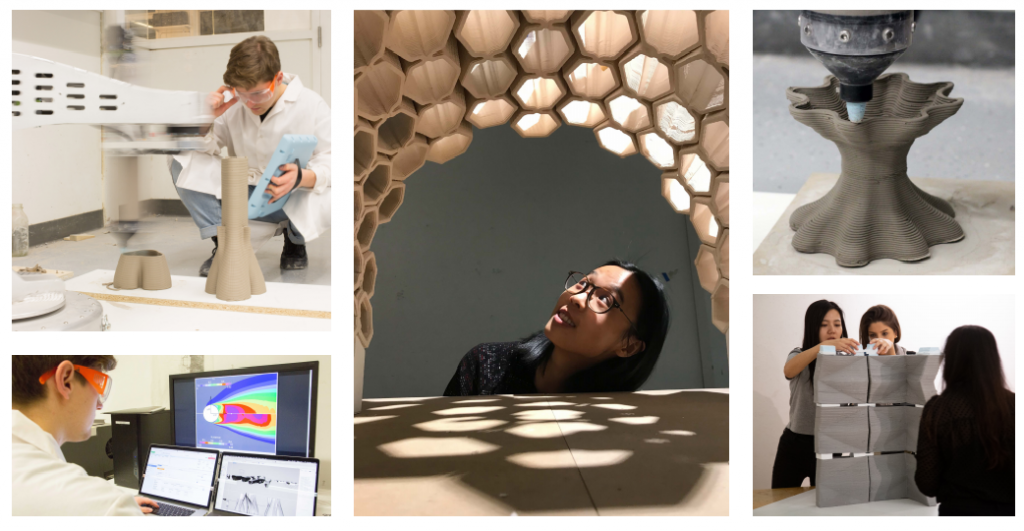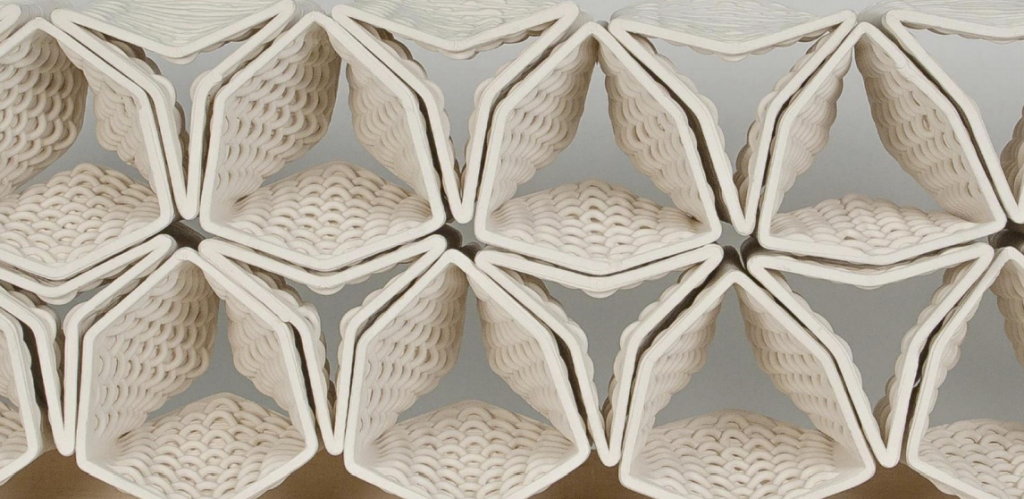Students at the University of Waterloo School of Architecture in Cambridge, Ontario are bringing a whole new meaning to mixed media as they take on both 3D printing and the use of ancient clay building materials.
A recent case study explains how 18 master’s students began a deep exploration not only of new technology but also endeavoring to make incredibly unique—and massive—objects, over a meter tall, including:
- A wall that whistles
- An arch doubling as a sundial
- A beautiful façade with intricate loops
“Everyone came out of it with something they’re super proud of—and surprised by,” said student Victor Tulceanu.
“It’s cool that we’re advancing this really rudimentary material. Nobody would have thought of even trying to do something like this 3,000 years ago because it’s just too complicated.”
Taking full advantage of the benefits of 3D design and printing, this student work is a perfect example of the infinite potential offered by both 3D design and printing; in other words, pretty much all you have to do is come up with a concept and then put it into action—whether in making solid objects or others that may also be integrated with electronics and more.
Here, the initial idea in using the new $20,000 3D printer at their school was simple: design a wall made from brick. The technology was new to everyone, so not only were they embarking on a design journey, but also one in learning about formidable new hardware. Professor David Correa states that as he sent the students on their way to begin, even he did not know what to expect.

L-R: Joanne Yau, Victor Tulceanu, and Yesul (Elly) Cho show off the bricks they made out of clay using a new 3D printer at the School of Architecture
The students were split into groups of three, each on a mission to fabricate masonry from the 3D printer. And while learning how to operate a new 3D printer (sponsored by MasonryWorx) for creating an industrial product may have seemed like the greatest challenge, first they were immersed in the world of materials science—learning about clay. Not only did they have to understand more about manipulating the material, and its properties, but also more about how it would respond in 3D printing.
“There is no other way to make these kinds of façades without enormous cost and time,” said Correa, who has been involved in 3D printed research on an even more advanced level, studying how such objects respond when exposed to varying degrees of moisture and temperature. “They are completely unique.”
With a world of customization available to them in both design and 3D printing capability, the students were able to design every brick to required specifications for the intricate projects at hand; for example, one wall not only whistled, but projected a variety of notes depending on the direction and velocity of the wind.
“It’s fascinating to think that we’re the only ones in the world who have ever made this geometry with this machine,” said student Yesul (Elly) Cho, part of one of the teams responsible for fabricating an interlocking brick wall.
The project sparked such an interest for Cho that she will be continuing to study 3D printing and hopes to attend conferences and write on the subject.
“The printer allows us to make much more complex geometry,” said Joanne Yau, part of the team that 3D printed bricks for the ambitious arch/sundial. “To make this by hand or to extrude it would be virtually impossible.”
Correa was pleased with the teams and the resulting projects, and states that he sees 3D printing as having great potential, with the surface just scratched so far in terms of what students can do—and on the large scale. There are plans to offer the class again this fall.
3D printing with clay has offered a path to innovation for designers around the world, from experimenting with nanoclay for bioprinting better scaffolds to clay nanocomposites with PLA to the use of 3D printing in sculpture. What do you think of this news? Let us know your thoughts; join the discussion of this and other 3D printing topics at 3DPrintBoard.com.
[Source / Images: University of Waterloo School of Architecture]
Subscribe to Our Email Newsletter
Stay up-to-date on all the latest news from the 3D printing industry and receive information and offers from third party vendors.
You May Also Like
Precision at the Microscale: UK Researchers Advance Medical Devices with BMF’s 3D Printing Tech
University of Nottingham researchers are using Boston Micro Fabrication‘s (BMF) 3D printing technology to develop medical devices that improve compatibility with human tissue. Funded by a UK grant, this project...
3D Printing Webinar and Event Roundup: April 21, 2024
It’s another busy week of webinars and events, starting with Hannover Messe in Germany and continuing with Metalcasting Congress, Chinaplas, TechBlick’s Innovation Festival, and more. Stratasys continues its advanced training...
3D Printing Webinar and Event Roundup: March 17, 2024
It’s another busy week of webinars and events, including SALMED 2024 and AM Forum in Berlin. Stratasys continues its in-person training and is offering two webinars, ASTM is holding a...
3D Printed Micro Antenna is 15% Smaller and 6X Lighter
Horizon Microtechnologies has achieved success in creating a high-frequency D-Band horn antenna through micro 3D printing. However, this achievement did not rely solely on 3D printing; it involved a combination...































